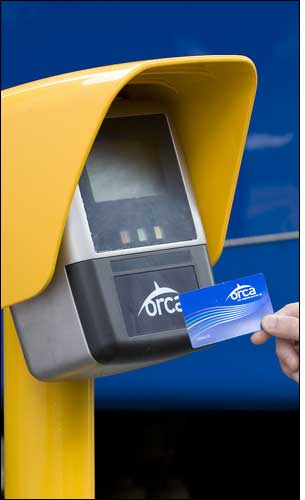A consortium of seven transit agencies, including Sound Transit—the Puget Sound’s regional transit authority, in the Seattle, Wash., area—are launching a system for transit users to access ferries, buses and trains by tapping a single RFID ORCA card. ORCA (the name is an acronym derived from the phrase “One Regional Card for All”) features a card containing a 13.56 MHz passive RFID tag that complies with Near Field Communication (NFC) specifications, enables passengers to load funds onto an account, from which they can then draw every time they ride a bus, train or ferry in Seattle, or in neighboring counties.
The system, including hardware, was provided by Vix ERG, an Australian provider of automated-fare-collection systems, and helps to solve the problem of a very diverse transit population that often uses multiple forms of transit on a single day. Many travelers arrive or leave the Seattle area by ferry, then subsequently ride buses or trains. Each transit agency has its own fare system, and paying for each ride often required multiple tickets or transit passes, or else they had to be managed with cash.
The solution, according to Brian Brooke, Sound Transit’s manager for research, policy and business development, is a contactless payment system that stores all transit payment data on a single server, and allows passengers to pay for multiple rides with one card. Initially, Brooke says, King County Metro, the Seattle area’s transit agency, had been exploring this technology to manage fare payments within the county, and it piloted a contactless system in the 1990s. Sound Transit was then formed, which included multiple transit agencies. The agency began researching a system that would make it possible for passengers to pay all of their fares on one regional transit pass.
“We have a lot of folks who live in one county and work in another,” Brooke explains, “and they use multiple transit service providers.” The coverage area encompasses King, Pierce, Snohomish and Kitsap counties, and includes the cities of Seattle, Tacoma, Bellevue, Everett and Bremerton, with 439 bus routes, 12 ferry routes, 73 miles of commuter rail and 17 miles of light rail. On an average weekday, he says, approximately 500,000 rides are recorded in the area, which serves a population of about 3.6 million. In that four-county area, there are roughly 300 different forms of tickets in use.
In 2006, the consortium completed a beta test of the NFC system, then introduced the system to a limited number of users earlier this year, before introducing it to the general public this fall. To date, approximately 150,000 riders are using the cards, but the group expects that number to rise, says Cheryl Huston, ORCA’s regional administrator, as more riders complete the use of their existing bus or ferry passes.
Each rider can now be issued an ORCA card at an agency office, or by mail. The user can sign up for auto-loading, which deducts a specified amount from that person’s bank account when his or her ORCA balance drops to a certain level. The card carries an NFC RFID chip with 4 kilobits of memory encoded with a unique ID number, as well as the amount of money stored for fare payments, explains John Winyard, Vix ERG’s VP. Funds can be loaded onto the card at a vending machine, or at an agency office. The RFID tag does not store personal information, such as a user’s name or account number.
When a rider uses one of 1,269 NFC-enabled buses, that individual taps his or her card near the vehicle’s NFC reader, which not only receives the ID number and data regarding available funds, but also deducts the correct amount from that balance and writes the new balance onto the tag. The reader also stores the ID number and new balance, to be downloaded to the Vix ERG server at the end of the day. The device itself illuminates a green light if the card is accepted, a yellow light if the balance is running low, or a red light if the card lacks sufficient funds.
At train stations, the card can be used at fixed card readers prior to entering a train, while staff members aboard the trains employ handheld interrogators to verify that passengers possess valid passes. At ferries, a user taps his or her card at a turnstile before entering a ferry. The group has installed a total of 126 train station readers, and 146 handheld interrogators are being used on the trains themselves. There are 97 NFC-enabled turnstiles at the ferry terminals.
Vix ERG’s server stores data regarding each rider, as well as his or her balance, and sends reports to the agencies at the end of the day. The company’s software manages that information, as well as the reading devices in buses, train stations and ferry terminals. Only train station vending machines and ferry terminal turnstiles are hardwired to a back-end system and can rout updates in real time. The bus devices store the data, then download it at the end of the day upon arrival at the Wi-Fi-enabled bus terminal.
The system has enrolled several large companies in the area, including Boeing, to purchase the cards for their employees. Participating firms can view or manage fare data for their staff on the ORCA Web site.
“The real advantage is not just for agencies, but for the passengers,” Huston states. “It makes the travel more seamless.”
Vix ERG has deployed similar solutions in San Francisco and Washington, D.C., Winyard says, as well as in Singapore, Hong Kong, Stockholm and Rome. The company not only provides the software and server, but also offers technical support in the event that a customer calls in to the ORCA help line (staffed by Sound Transit’s employees) and requires specialized assistance. In such a case, the call is then forwarded to Vix ERG.


